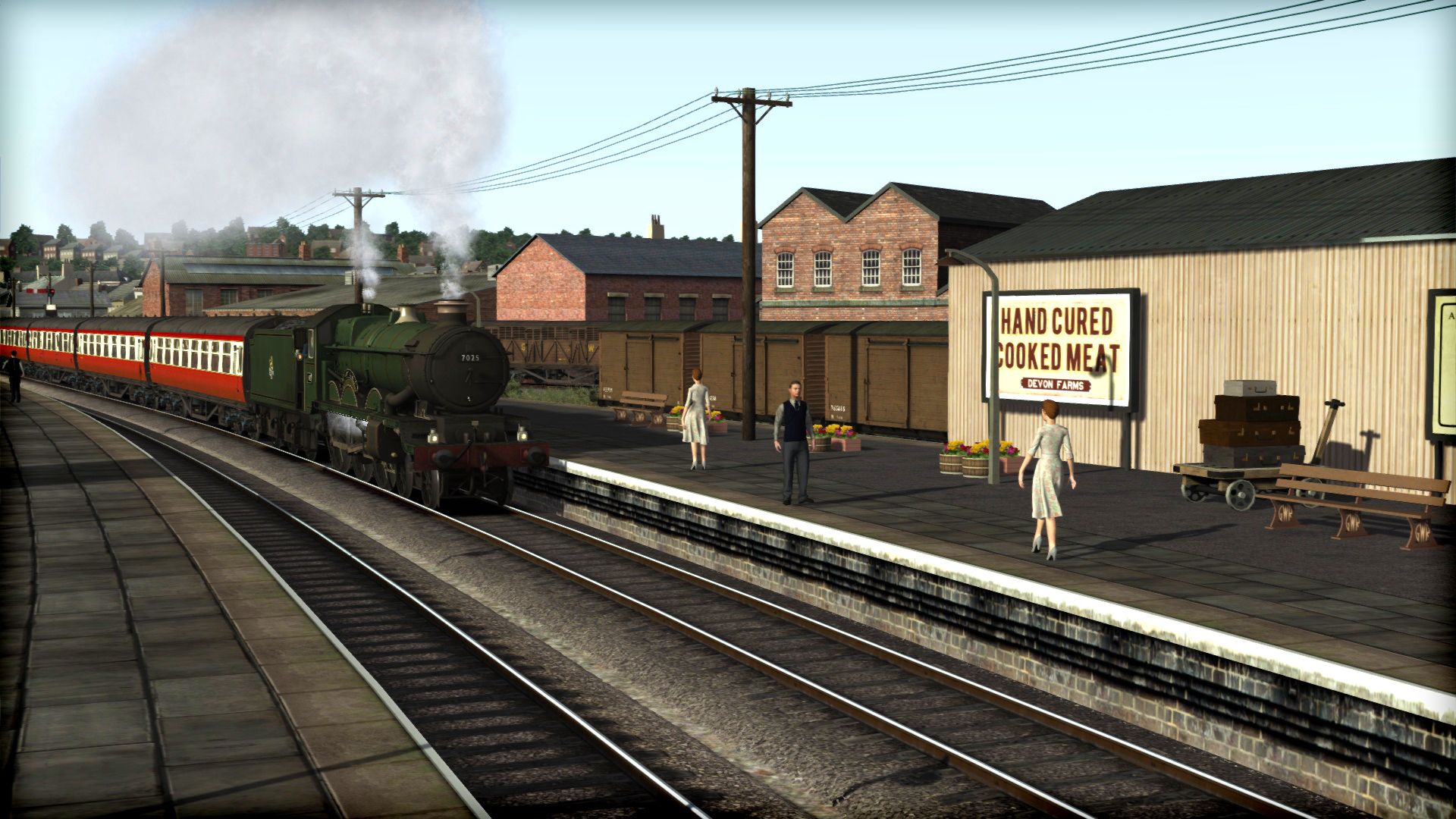Train Simulator: Riviera Line in the Fifties: Exeter to Kingswear
Buy Train Simulator: Riviera Line in the Fifties
Click one of the buttons below to purchase Train Simulator: Riviera Line in the Fifties. Different vendors often have sales at different times, always check all vendors for the Train Simulator: Riviera Line in the Fifties lowest price*.
Incorporated by an Act of Parliament in 1835, the origins of the Great Western Railway lay with merchants from Bristol who felt threatened by the growing strength of Liverpool as a major trading port through its development of a railway connection to London. In order to maintain the importance of their own port, a railway to the west was most definitely needed!
Infamous for its use of the alternative ‘Broad Gauge’ 7ft infrastructure, the GWR was happy to wage war with other developing railway companies throughout the remainder of the 1900s, as lines extended across much of the country using mostly ‘Standard Gauge’ 4ft 8½in. Slowly though ‘Mixed Gauge’ began to eat its way south into GWR territory as the arrangements for transhipment from one mode to the other for onward travel became a major bugbear. Following further action from Parliament, the continuation of Broad Gauge was a lost cause. However, the required space for operating a Broad Gauge railway meant that on conversion to Standard Gauge, available land was extremely generous. Something which the GWR would not always learn to take advantage of as we shall see from one particular line on the south coast.
Construction of the line from Newton Abbot to Kingswear occurred in stages between 1852 and 1864 and, unlike other branch line additions, this one attracted higher than expected patronage from the very beginning. No later than the 1890s, the railway was the sole factor in establishing Torbay as one of the top holiday destinations of the era. By 1905 the line was doubled, although curiously only as far as Paignton, leaving the final six miles to Kingswear as single track. Given continued exceptional growth in traffic through to the 1930s, the GWR was forced to begin works to enlarge Paignton, though sadly this was interrupted by the onset of war, and ultimately the plans never became reality. Had any of the other ‘Big Four’ operated the route, no doubt Paignton would have developed into a major terminus, but continuing under the GWR the endless line of holiday trains had to be processed by a facility with no more than one platform for each direction. To suggest this was still just a ‘branch line’ was an understatement as it was not uncommon even on weekdays that more trains were bound for Torbay, than those to Plymouth or Penzance.
The line down from Exeter St David’s to Kingswear is defined by two constituent parts – the high speed coastal run, skirting the beaches and bays along the Dawlish Sea Wall; and the mountainous curvaceous crawl down to the seaside resorts. Operating the required trains and timetables therefore required crews of very broad experience and skills, especially given that to keep everything moving services frequently operated very early in the morning and usually late into the night. Add in the occasional channel storm and you have ingredients for some very weathered men and machines.
Both Exeter and Newton Abbot were well established locomotive depots by the peak of steam operation of the route in the 1950s, with full compliments of water, coal, turntables and extensive maintenance facilities, let alone vast stabling sidings for stock to cater for any and all requirements. Most engines would visit one of these locations during their time in the area, aside from those allocated to the depots permanently.
Paignton and Kingswear equally featured facilities to establish themselves, with the latter complimented by its own turntable, even if it was somewhat squeezed into the limited available space. To relieve Paignton of some of the stresses, nearby Goodrington Sands Halt was extensively expanded to provide lengthy carriage sidings. Efforts went even further by starting some services at the Halt, and while this only consisted of four northbound trains a day, between them some 36 coaches and over two thousand passengers would be catered for in just a few hours!
To facilitate all this traffic, what about looking at the prestigious motive power developed and assigned to the significant task of keeping the south coast moving, and the GWR is certainly famous for its contributions to the history of steam traction.
Eighth in line as Locomotive Superintendent at the GWR, Charles Collett was following in the footsteps of some very big names for engine design. Isambard Kingdom Brunel himself, William Dean and George Jackson Churchward to name but a few to have gone before and left their mark on the rails to the west.
Taking up the post in 1922, Collett was first presented with the myriad of locomotive types absorbed from company mergers that in several cases would continue to occur for years to come. Collett was quick to establish a means of standardisation by rebuilding many locomotives using common GWR manufactured parts from Swindon works. Though this was not his desired focus.
Charles Collett wanted to design modern new locomotives, and it was in this field where he was able to leave one of the most significant marks in the GWR history. Wishing to replace many older types with bigger and better performing machines, Collett would apply his attention to both tank and tender types, producing no less than 25 different designs that would see full production during his occupancy.
Amongst those productions would come some of the most iconic locomotives of the day. The GWR being what it was, which some would claim as the birth of modern marketing techniques, Collett was responsible for the powerfully named Castle, Hall, Pannier, Grange and ultimate of them all, King classes. All being of the 4-6-0 type with the exception of the Pannier, the locomotives would all be ideal express operators for the GWR. Each one of these designs carrying appropriate names both for themselves and the services they hauled.
This was indeed the pinnacle of steam locomotive development at the GWR. For it was also under the reign of Charles Collett that diesel power would first appear, and hence forth the landscape of railway traction would change forever.
Transfer this world to the realms of Train Simulator and you can see we have the setting for a most amazing experience with the pressures of squeezing mainline traffic onto branch line facilities; from shunting coaching stock, to hauling holiday expresses and from managing locomotives to maintaining the timetable.
Includes:
- GWR 4073 Class (Castle Class) in Brunswick Green, Wartime and Weathered Liveries
- GWR 4073 Class (Castle Class) Double Chimney Variant in Brunswick Green Livery
- GWR 5700 Class (Pannier Tank) in Brunswick Green, Clean and Weathered Liveries
- GWR 6000 Class (King Class) in Express Blue and Brunswick Green Livery
- GWR 6800 Class (Grange Class) in Brunswick Green, Clean and Weathered Liveries
- GWR 6959 Class (Modified Hall Class) in Brunswick Green, Clean and Weathered Liveries
- Hawksworth Centenary Coaches in Blood & Custard Livery
- GWR Collett Excursion Coaches in Blood & Custard and Maroon Liveries
- BR Mk1 Coaches in Chocolate & Cream Livery
- GWR 3, 5 and 7 Plank Wagons, Standard Vans, Fish Vans, Milk Tanks, Siphon G Wagons and 20T GWR TOAD Brake Van
- Advanced steam engine simulation for all included locomotives
- Steam Chest & Steam Heat Simulation
- Larger Hawksworth Four-Row Superheater Simulation (Castle Class)
- Live & Exhaust Water Injector Function
- Advanced Particle Emitter Function
- Fire Pulsing & Visible Fire Level
- Realistic Wheelslip/Sanding Function
- Realistic Cylinder Cock Control + Damage Simulation
- Realistic Boiler Priming Simulation
- Shifting Water Acceleration/Braking Simulation
- Water Sight Glass + Regulator Lubrication
- Water Trough Tender Refilling Function
- Small & Large Ejector Function
- Headcode & Headboard Function
- Cab & Instrument Lighting (Where Appropriate)
- Quilling Whistle
- Smokebox Door, Blowdown & Ashpan Simulation
- Driver Assist Functionality
- Accurate sounds provided by Steam Sounds Supreme
- Fifteen challenging career and three Railfan Mode scenarios
Train Simulator: Riviera Line in the Fifties Manual
Dawlish Live Railcam
Riviera Line Books
Browse a range of books related to this route. Click on an image to view the product page. Please note that prices are subject to change.















